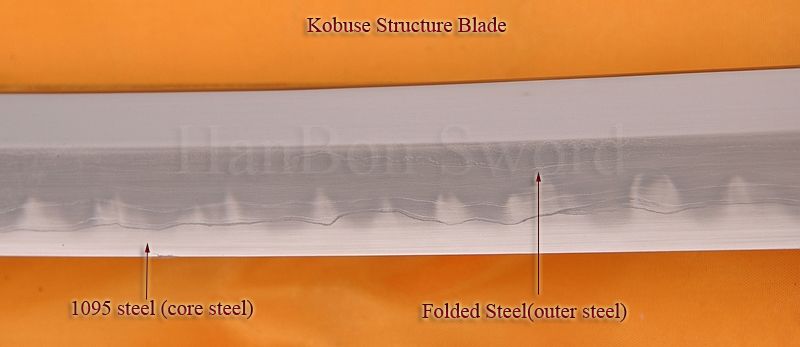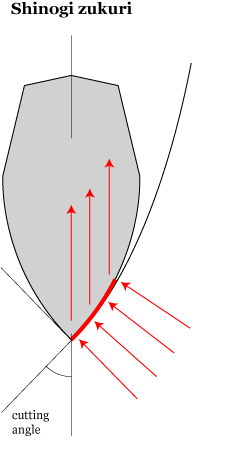How to choose a blade

How to choose a Blade
There are many types of Japanese swords that differ by size, shape, field of application and method of manufacture. Some of the more commonly known types of Japanese swords are the katana, wakizashi, odachi, tachi.

Get a blade made of carbon steel if you want to occasionally use it. A sword made from stainless steel is almost for decoration or kitchenware, we have no stainless steel blades. Please make up your own mind on what types of steel best suit your preference (and budget) in a sword. It just depends on what you are looking for in a blade, what you like and your intended usage.
1.What can sword blades be made of?
Followings are the most popular carbon steel blades:
1060 carbon steel is a fairly basic steel with only Carbon and Manganese added to the Iron, has the lowest practical carbon content of 0.60%. 1060 steel is inexpensive and relatively easy to grind and work with. It offers a great compromise between hardness (edge holding ability) and pliability (strength), so 1060 Carbon Steel swords are very popular.
1095 is sort of the "standard" carbon steel, it is categorized on the basis of 0.95% carbon. 1095 qualifies as a high-carbon hardened steel. It offers the highest carbon content, it yields the sharpest edge. Toughness, hardness and durability make 1095 steel the most-popular choice for swords. 1095 Carbon steel is very HARD - and unless it is properly heat treated, this hardness can sometimes be problematic when used on harder targets. When tempered properly, 1095 steel is great for swords as when it is clay tempered.
9260 Spring Steel (also called Silicon Manganese Steel) consists of 2% silicon content, giving it an even more dramatic resilience against lateral bends and allowing it to spring back to true even after being bent almost to 90 degrees. The 9260 spring steel has a significantly increased fatigue resistance compared to its nearest similar standard 1060 carbon steel. 9260 has the capability to be a harder blade, the incredibly crafted blade that has both strength and flexibility makes a high-quality katana sword.
Folded Steel Blade:
A folded steel blade is typically made from high carbon steel. The difference is that its process is the folding of the steel, where the swords are made by repeatedly heating, hammering and folding the metal. Our folded steel blade is folded 13 times creating 8192 layers. Folded steel makes the blade a better cutter and more durable.
Clay-Tempered is the process of using clay to insulate the parts of the metal that you want softened so that when the sword is heated and quenched, they cool more slowly. The edge of the blade still retains more of its hardness than the rest of the sword because of the clay-tempering process that it went through. You can actually see the difference in hard and soft metal because there is a visible temper line on the blade, also called the hamon (beautiful curves), there are numerous styles of hamon . Clay treatment has to be operated by professional to be efficient. The end result is an incredibly crafted blade that has both strength and flexibility, which is the hallmark of a high-quality sword.
Hazuya is a specific stone to bring up hamon, the stone is very fine and soft against the steel. The work is done to get mirror-like surface on shinogi-ji and edge. Hazuya polish is usually considered a more honest polish for inspecting the blade's tempering process.
Kobuse Blade (Folded steel+1095 steel):
It is constructed of two different kinds of steel, the 1095 core steel and the outer folded steel, where the core steel is wrapped with the outer steel, the core steel is harder than the outer steel. Both high carbon steels work together and the end result is a sword designed for high performance cutting. This modern day production uses the same production methods used to forge the renowned Japanese samurai swords of times past.

2. What styles in shape of blades?
There are a variety of shapes of Japanese sword blades, kissaki (points) and blade backs (mune). Some of the most common of shown below.
• Shinogi-Zukuri Blade Shape
• Unokubi-Zukuri Blade Shape
• KIRIHA ZUKURI Blade
• Sakabato (reverse-edged blade)
• Chu-kissaki (medium)
• O-kissaki (long)
• KO-kissaki (short)





Blood groove allows for a lighter blade and audible feedback when swung, no hi blade is to enhance the strength and cutting power of a sword. The choice of blade shape comes down to personal preference, with generally a choice of carved, straight. Most people choose carved katana blade, but you should use whatever feels most favorite for you. There are no rules the shape of the blade or the bloode grooves, so you can customize or choose one to your own perferences.
Swords are extremely dangerous and should be handled and displayed with extreme caution. Normally functional swords come with blades that are sharpened, it is a real weapon. Be sure to confirm with the manufacturer in advance or have a note when place an order. If you're concerned about safety or use for a training, leave the blades dull.
Click HERE to learn more details.
Want a unique sword? Feel free to contact us:
Skype: hanbon-sword
Phone: 086 13739276006
Email: [email protected]
Website: www.hanbonforge.com
Custom Sword Page: www.hanbonforge.com/CUSTOM-SWORDS/Custom-Your-Own-Swords

3 Comment(s)
Make a Ken sword with a two-edged blade. The blade's gotta be straight AND symmetrical. Make it a Ryo-shinogi-zukuri.
Make a full-tang European style sword that's sharp, straight, AND strong. It's gotta have the one-handed ricasso that's long enough ta serve as an addition grip (like the ricassos on Zweihanders, but no spikes on this blade), the 6-sided hexagonal blade section, the symmetrical sharp edges, the sharp point, AND the downturned quillons that're swept to the blade's direction. The tripartite guard, the handle, AND the pommel could be gold-plated. Give the winged crossguard just 2 red gems. The gems SHOULD be in the middle o' the guard, one red gem in the middle on both sides. The blade's gotta be 9260 high carbon steel. The blade's gotta be colored with the light blue color, like sky blue. The blade's gotta be 21 inches long. The handle's gotta be be 9.5 inches long. The scabbard could have the lion motif. The downturned quillons could be the same as the Master Sword's quillons. Don't make the sword too heavy. It's gotta be more manageable.
There are many blogs on the Internet. But I can definitely say that your blog is amazing. It has all the qualities a perfect blog should have
Leave a Comment